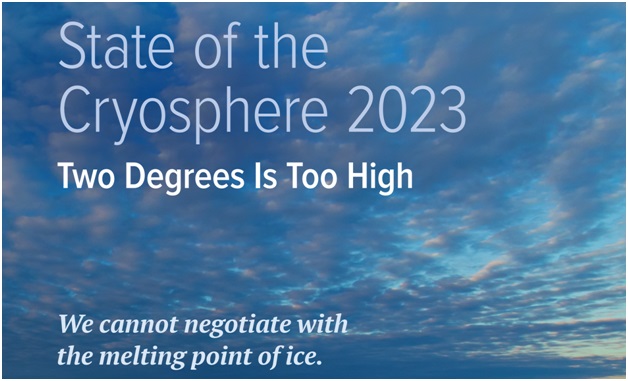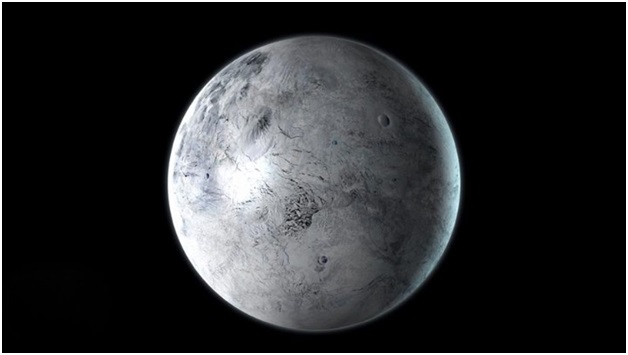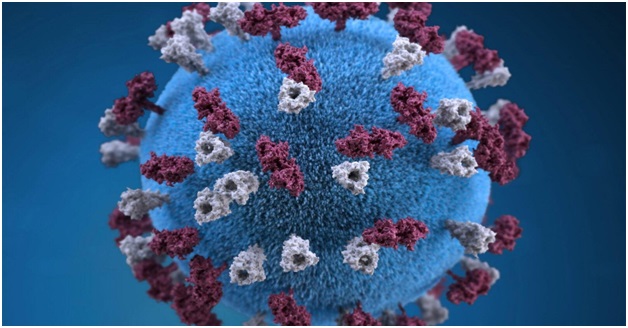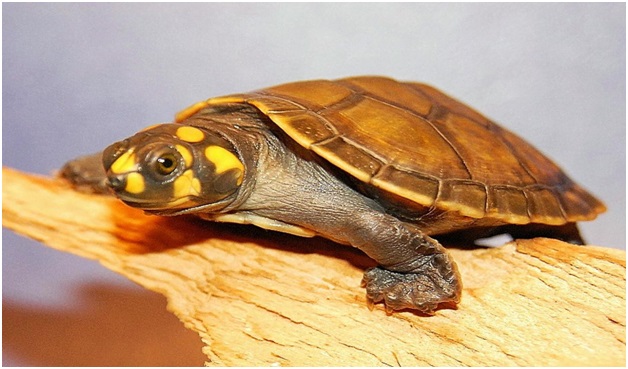State of the Cryosphere Report 2023 (DownToEarth)

- 18 Nov 2023
Why in the News?
As per the 2023 State of the Cryosphere report, the anticipated disappearance of almost all tropical glaciers, a significant majority of mid-latitude glaciers, and polar regions is expected, even if global efforts successfully limit the rise in temperatures to 2 degrees Celsius above preindustrial levels.
About the State of the Cryosphere Report 2023:
- The State of the Cryosphere Report annually assesses the condition of Earth's snow and ice regions, and has been reviewed and endorsed by over 60 leading cryosphere scientists.
- This report is published by The International Cryosphere Climate Initiative (ICCI.)
- The cryosphere is a term for the regions of our globe that are covered in ice and snow – either seasonally or year-round.
- The Report describes how a combination of melting polar ice sheets, vanishing glaciers, and thawing permafrost will have rapid, irreversible, and disastrous impacts worldwide.
Key findings in the report on the impact of 2°C of warming include:
- Ice sheets: nearly all of Greenland, much of West Antarctica, and even vulnerable portions of East Antarctica will be triggered to very long-term, inexorable sea-level rise.
- Glaciers: extensive, irreversible ice loss from the world’s glaciers in many major river basins, with some disappearing entirely.
- As glaciers melt, risks of catastrophic events such as landslides, sudden ice shears, and glacial lake outburst floods increase.
- Sea ice: extensive sea ice loss at both poles, with severe feedback to global weather and climate.
- By 2°C, the Arctic Ocean will be sea ice-free in summer every year, potentially for several months.
- Permafrost: extensive permafrost thaw and resulting greenhouse gas emissions will cause temperatures to continue to rise, even once human emissions reach zero.
- At 2°C, annual total permafrost emissions (both CO2 and methane) would total the size of the entire European Union’s emissions from 2019.
- Polar ocean acidification: year-round, permanent corrosive ocean acidification conditions in many regions of Earth’s polar and near-polar seas.
- Shell-building animals and commercial fisheries that rely on them in the food chain may not survive.
About International Cryosphere Climate Initiative (ICCI):
- It was formed in 2009 following COP-15 in Copenhagen
- ICCI is a network of senior policy experts and researchers working with governments and organizations to create, shape, and implement initiatives designed to preserve as much of the Earth’s cryosphere as possible.
- ICCI programs target the unique climate dynamics at work in the cryosphere, while at the same time lending increased urgency to global climate efforts aimed at CO2 and other greenhouse gases by communicating the unexpected rapidity and global implications of cryosphere warming.
Dwarf Planet Eris (The Hindu)

- 18 Nov 2023
Why in the News?
Recently, scientists have discovered the inside structure of the enigmatic dwarf planet Eris.
About Dwarf Planet Eris:
- This new dwarf planet is the largest object found in orbit around the sun since the discovery of Neptune and its moon Triton in 1846.
- It was discovered on Jan. 5, 2005, and It is larger than Pluto, discovered in 1930.
- Like Pluto, the new dwarf planet is a member of the Kuiper belt, a swarm of icy bodies beyond Neptune in orbit around the sun.
- Eris is named for the ancient Greek goddess of discord and strife.
- The surface of Eris is extremely cold, so it seems unlikely that life could exist there.
- With a radius of about 1,163 kilometers, Eris is about 1/5 the radius of Earth.
- Eris, like Pluto, is a little smaller than Earth's Moon.
- Eris takes 557 Earth years to make one trip around the Sun.
- As Eris orbits the Sun, it completes one rotation every 25.9 hours, making its day length similar to ours.
- Moons: Eris has a very small moon called Dysnomia.
- Dysnomia has a nearly circular orbit lasting about 16 days.
- Eris most likely has a rocky surface similar to Pluto.
- Atmosphere: The dwarf planet is often so far from the Sun that its atmosphere collapses and freezes, falling to the surface as snow.
- As it gets closest to the Sun in its faraway orbit, the atmosphere thaws.
Card-on-File Tokenisation (CoFT) (Business Standard)

- 18 Nov 2023
Why in the News?
Recently, Visa has highlighted that the primary advantage of tokenization is a decreased risk of data breaches.
What is Card-on-File Tokenisation?
- Tokenisation is a process where the cardholder’s original card number, one which is written on the card and is extensively used for transactions and card identification, is replaced with a surrogate term called ‘token.’
- This process allows enhanced card protection by converting the customers’ card numbers into tokens.
- The exchange of tokens happens between the token requestor and the network, which empowers customers to receive a secure and reliable online payment experience.
- All relationship evidence of such exchange between token and crucial card information is securely saved in a vault that is only accessible to the card networks.
- Resultantly, the customers’ card details will be highly protected from online fraud and hackers.
How Does Card-on-File Tokenisation Work?
- When a customer makes a transaction by using their card at a tokenisation-based-authentication server:
- A credit/debit card is used for transactions at a POS device or an e-commerce website
- The tokenisation system receives and interprets the credit card number
- The tokenisation system goes on to replace the original credit card number with a 16-digit random character token for security
- The tokenisation system then provides the converted 16-digit random token number to the e-commerce marketplace and replaces the user’s credit card number with the same in their system
- For instance, card number (example): 4018 2255 6984 7854 will be replaced with token number: 4325 5214 8574 6658.
- The tokenisation system is an important tool for separating crucial data in ecosystems and databases while also offering enhanced card protection to cardholders.
Measles (Indian Express)

- 18 Nov 2023
Why in the News?
An estimated 11 lakh children in India missed their crucial first dose of measles vaccine in 2022, according to a report by the World Health Organization and US Centres for Disease Control and Prevention (CDC).
What is Measles?
- Measles is a highly contagious disease caused by a virus.
- It is caused by the Morbillivirus of the Paramyxoviridae family.
- It spreads easily when an infected person breathes, coughs, or sneezes.
- It can cause severe disease, complications, and even death.
- Measles can affect anyone but is most common in children.
- Measles infects the respiratory tract and then spreads throughout the body.
- Symptoms: Symptoms include a high fever, cough, runny nose, and a rash all over the body.
- Measles typically starts with a strong fever about 10 to 14 days after getting infected.
- In the beginning, it starts with a runny nose, cough, red and watery eyes, and small white spots inside the cheeks.
- After a few days, a rash appears, usually on the face and upper neck.
- This rash spreads over about three days, reaching the hands and feet, and lasts for five to six days before fading away.
- Any non-immune person (not vaccinated or vaccinated but not developed immunity) can become infected.
- If a woman catches measles during pregnancy, this can be dangerous for the mother and can result in her baby being born prematurely with a low birth weight.
- Treatment: There is no specific treatment for measles.
Amazon Yellow Spotted River Turtle (The Hindu)

- 18 Nov 2023
Why in the News?
In the Peruvian Amazon, an extended heat wave and drought have shortened the incubation period for thousands of turtle hatchlings released into the river by biologists as part of a local environmental program.
About Amazon Yellow Spotted River Turtle:
- This species is one of the largest South American river turtles.
- It is characterized by its dark upper shell and yellow spots on the head, which fade with age.
- They are considered side-necked turtles because they cannot pull their heads into their shells.
Native Habitat:
- Yellow-spotted River turtles are native to the Amazon River basin and can be found in the Amazon and Orinoco river systems in Venezuela, eastern Colombia, eastern Ecuador, northeastern Peru, the Guianas, Brazil and northern Bolivia.
- These turtles spend time basking along the riverbanks and in the calm waters of big rivers and streams.
- They avoid fast-moving waters.
Food/Eating Habits:
- They are omnivorous, feeding on both vegetation and small animals.
Reproduction and Development:
- Females lay their eggs in the peak of the dry season and the nests are sometimes destroyed by rising flood waters.
Sleep Habits:
- The turtles are diurnal, meaning they are most active in mid-morning and afternoon.
Lifespan:
- The oldest known yellow-spotted Amazon River turtle living in human care reached 23 years of age.
- They can live up to 70 years.
